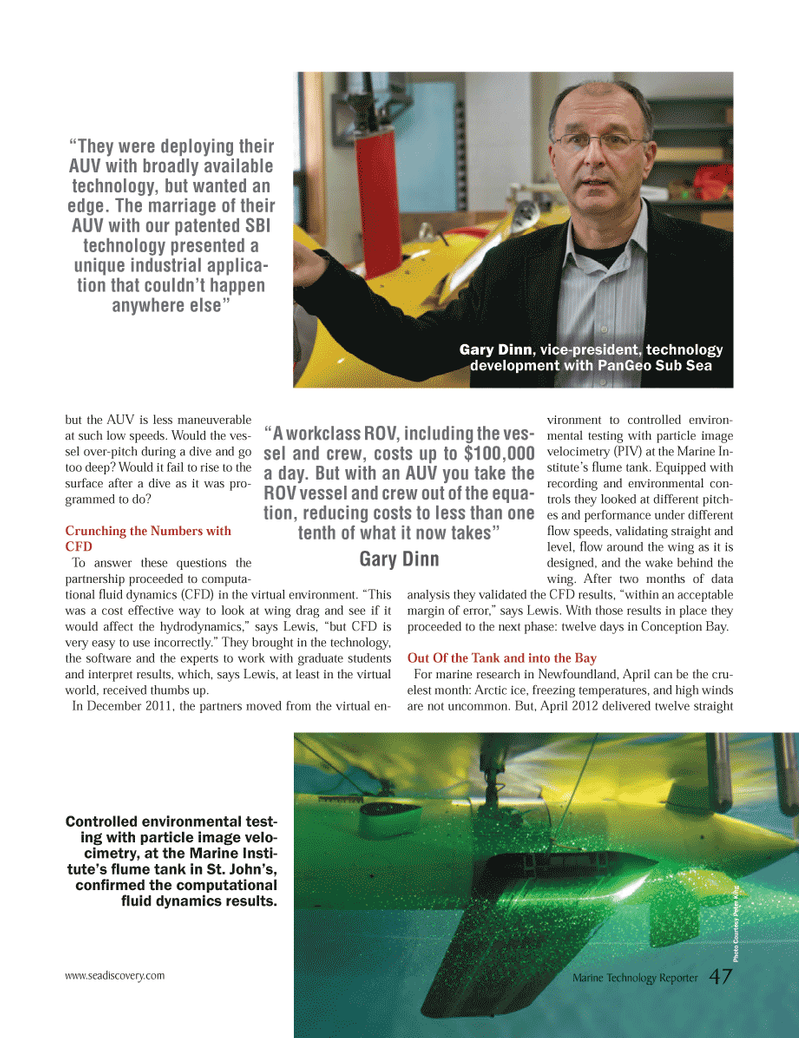
Page 47: of Marine Technology Magazine (June 2012)
AUV Arctic Operations
Read this page in Pdf, Flash or Html5 edition of June 2012 Marine Technology Magazine
but the AUV is less maneuverable at such low speeds. Would the ves- sel over-pitch during a dive and go too deep? Would it fail to rise to the surface after a dive as it was pro- grammed to do? Crunching the Numbers with CFDTo answer these questions the partnership proceeded to computa-tional ß uid dynamics (CFD) in the virtual environment. ÒThis was a cost effective way to look at wing drag and see if it would affect the hydrodynamics,Ó says Lewis, Òbut CFD is very easy to use incorrectly.Ó They brought in the technology, the software and the experts to work with graduate students and interpret results, which, says Lewis, at least in the virtual world, received thumbs up. In December 2011, the partners moved from the virtual en- vironment to controlled environ- mental testing with particle image velocimetry (PIV) at the Marine In- stituteÕs ß ume tank. Equipped with recording and environmental con- trols they looked at different pitch- es and performance under different ß ow speeds, validating straight and level, ß ow around the wing as it is designed, and the wake behind the wing. After two months of data analysis they validated the CFD results, Òwithin an acceptable margin of error,Ó says Lewis. With those results in place they proceeded to the next phase: twelve days in Conception Bay. Out Of the Tank and into the Bay For marine research in Newfoundland, April can be the cru- elest month: Arctic ice, freezing temperatures, and high winds are not uncommon. But, April 2012 delivered twelve straight Controlled environmental test- ing with particle image velo- cimetry, at the Marine Insti- tute?s ß ume tank in St. John?s, conÞ rmed the computational ß uid dynamics results. Photo Courtesy Peter King Gary Dinn , vice-president, technology development with PanGeo Sub Sea ?They were deploying their AUV with broadly available technology, but wanted an edge. The marriage of their AUV with our patented SBI technology presented a unique industrial applica-tion that couldn?t happen anywhere else??A workclass ROV, including the ves- sel and crew, costs up to $100,000 a day. But with an AUV you take the ROV vessel and crew out of the equa-tion, reducing costs to less than one tenth of what it now takes?Gary Dinn Marine Technology Reporter 47 www.seadiscovery.com MTR #5 (34-49).indd 47MTR #5 (34-49).indd 475/31/2012 10:30:20 AM5/31/2012 10:30:20 AM

 46
46

 48
48
